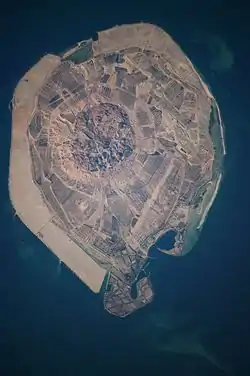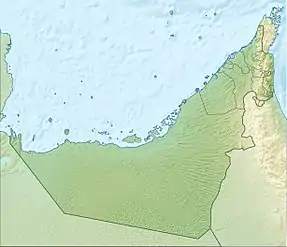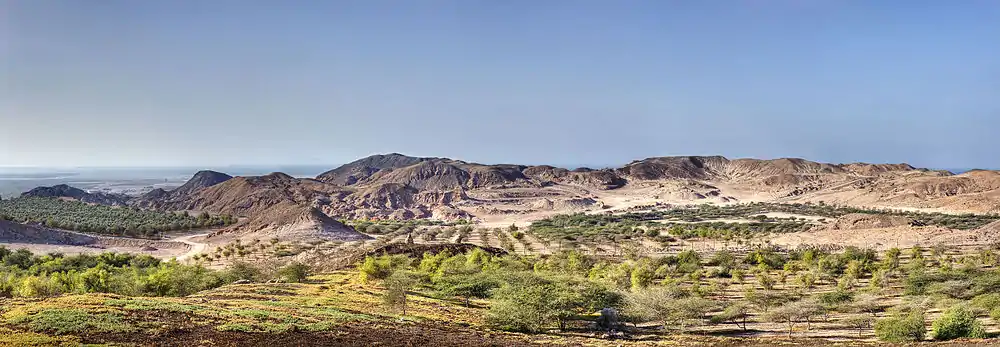Sir Bani Yas
Ṣīr Banī Yās (Arabic: صِـيـر بَـنِى يَـاس) is a natural island located 170 km (110 mi) southwest of Abu Dhabi, the capital of the United Arab Emirates. It lies 9 km (5.6 mi) offshore from Jebel Dhanna, which serves as a crossing point to other islands such as Dalma. Sir Bani Yas is 17.5 km (10.9 mi) from north to south and 9 km (5.6 mi) from east to west,[1] making it the largest natural island in the United Arab Emirates. Located just off the shore of the western region of Abu Dhabi, Sir Bani Yas was originally home to Arabia's largest wildlife reserve. Spanning over 87 km2 (34 sq mi), the reserve was established in 1977 by Sheikh Zayed Bin Sultan Al Nahyan.[2] Thanks to decades of conservation work and ecological investment, it is now home to thousands of large free-roaming animals and several million trees and plants. A bird sanctuary as well as a wildlife reserve, Sir Bani Yas showcases nature through activities such as adventure safaris, kayaking, mountain biking, archery, hiking and snorkeling.
| Native name: صِـيـر بَـنِى يَـاس | |
|---|---|
 This astronaut photograph illustrates the varying character of surfaces on Sir Bani Yas | |
 Ṣīr Banī Yās | |
| Geography | |
| Location | Persian Gulf |
| Coordinates | 24°20′N 52°36′E |
| Area | 87 km2 (34 sq mi) |
| Length | 17.5 km (10.87 mi) |
| Width | 9 km (5.6 mi) |
| Administration | |
| Emirate | Abu Dhabi |
| Demographics | |
| Ethnic groups | Arabs |
History
The name Sir Bani Yas originates from the Bani Yas tribe, who first inhabited Abu Dhabi. Sir Bani Yas is the crest of a salt dome created millions of years ago by natural geological forces.
The first human settlers arrived several thousand years ago. Thirty-six archaeological sites have been discovered throughout Sir Bani Yas, each providing a distinct insight into the island's history. One of the oldest sites is the remains of a Nestorian Christian monastery which dates back to 600 AD. Each of these sites has now been carefully covered, to protect them until the time when they can be incorporated into the destination experience.
The island has a number of significant historical sites, including remnants of Late Stone Age and early Islamic structures.[3] The island is also the location of the only pre-Islamic Christian site to be found in the UAE.[4] The 7th-century Christian church was opened to the public in mid-December 2010. It was discovered in 1992 and has been the focus of archaeological investigation under a team led by Dr. Joseph Elders. Dr. Elders claims the church was used by Nestorian Christians until about 750 AD.[5]
Sir Bani Yas was first mentioned in European literature around 1590, when the Venetian jeweller Gasparo Balbi listed "Sirbeniast" as an island around which pearls were often found. It was also described in some detail during the 1820s and 1850s by British naval officers who were surveying the lower Gulf waters.
In 1971 Sheikh Zayed became the first president of the United Arab Emirates, and chose this island as a retreat. In 1977, he passed a law prohibiting hunting on the island and started developing it as a wildlife preserve in his "Greening of the Desert" programme,[2] which was designed to help make the deserts more suitable for human settlement and provide a haven for many of Arabia's endangered wildlife species. Several millions trees were planted and numerous animals species introduced to the island, including gazelle, oryx, llama, rhea, giraffe, and ostrich. Once the reserve was established, Sheikh Zayed wanted to share the results with the world; hence it was opened to weekend tourists. These tours soon became so popular that visits would often have to be booked over one year in advance.
In 2007, the Government of Abu Dhabi established the Desert Islands. This brought together Sir Bani Yas, neighboring Dalma Island, and six surrounding sandy outcrops into one destination. Sir Bani Yas and Dalma Islands are developed and can be visited, but the 6 discovery islands are currently closed to the public.[6]
Wildlife and nature
The island is home to many species, from Arabian oryx, Somali ostrich, gazelle and deer to reticulated giraffes, dolphins and sea turtles. Many of the more than one-hundred species of wild birds which can be found on the island are indigenous to the region. The island is home to around 30 species of mammals, including a variety of antelope and one of the world's largest herd of endangered Arabian oryx. The Arabian oryx, a species of antelope, was formerly extinct in the wild, but the island is home to a herd of over 400 who roam freely on the island.
Taking up about half of Sir Bani Yas, the Arabian wildlife Park provides an environment for wild animals to freely roam while the island remains open for visitors. The Park houses some 13,000 animals indigenous to the Arabian Peninsula including the endangered Arabian Oryx, Sand Gazelle and Mountain Gazelle as well as free-roaming predators and scavengers such as the Sudan cheetah and striped hyena.[7]
While research and conservation efforts are a major part of the park's current development, a number of wildlife and adventure activities are already available for visitors. These include game drives, nature trails, mountain biking, and outdoor dining.
Sir Bani Yas is home to many animals that the International Union for Conservation of Nature classifies as critically endangered or vulnerable, including sea turtles, sand gazelles, Urial sheep, Barbary sheep, and Arabian tahr[8][9] and oryx. Therefore, the island plays a significant role in protecting these animals for future generations. More than 10,000 animals from Sir Bani Yas have been released into wildlife reserves such as the one in the Liwa Desert, on the Abu Dhabi mainland. This programme has been carried out in conjunction with the Environment Agency Abu Dhabi.
Hospitality
Located adjacent to a lagoon, on the northwest reaches of the island, is the Desert Islands Resort & Spa by Anantara with 64 rooms including six private lodges. The resort is also home to three restaurants, a spa, health club, kids club and business facilities.[10]
TDIC (Tourism Development and Investment Company) has announced in May 2014 that it was marketing a new hotel lease possibility in the island.[11]
Several cruise lines, in particular MSC Cruises, uses a small section of the island as a Private island destination on week long cruises. The section contains beaches and several bar and buffet areas.
Sustainability
The island is being developed with respect to its nature and delicate ecosystem. The island operates the region’s first wind turbine, which has a production capacity of 850 kilowatts is currently it is producing energy to power the island’s facilities alongside conventional supply from the national grid. The island also uses solar energy to power part of the staff accommodation which is not currently connected to the electricity grid.[12]
The Abu Dhabi-based renewable energy company Masdar has declared plans to raise wind production capacity to 30 megawatts.[13]
Transportation
Flights are available through Sir Bani Yas Airport.
References
- "Sir Bani Yas ADIAS Guide". adias-uae.com. Abu Dhabi Islands Archeological Society. Retrieved December 13, 2014.
- "Historical Timeline". sirbaniyasisland.com. Sir Bani Yas Island, Desert Islands. Retrieved December 13, 2014.
- "Sir Bani Yas Island is rich with history - The National". Archived from the original on 2010-12-16.
- "Ancient Christian site opens in UAE".
- "About Desert Islands". sirbaniyasisland.com. Sir Bani Yas Island, Desert Islands. Retrieved December 13, 2014.
- "Arabian Wildlife Park". sirbaniyasisland.com. Sir Bani Yas Island, Desert Islands. Retrieved December 13, 2014.
- "Endangered Arabian tahr born on Sir Bani Yas Island". The National. 2015-01-11. Retrieved 2018-04-02.
- "Endangered Arabian tahr born on Sir Bani Yas Island". Gulf News. 2018-01-13. Retrieved 2018-04-02.
- "Desert Islands Resort & Spa by Anantara". anantara.com. Anantara. Retrieved December 13, 2014.
- "New hotel project for Abu Dhabi's Sir Bani Yas Island". The National. The National. May 26, 2014.
- "Sir Bani Yas staff village". Enerwhere. Retrieved 14 February 2016.
- Cronin, Sean (June 14, 2014). "UAE looks to tap vast potential of wind power". thenational.ae. The National. Retrieved December 13, 2014.
External links
| Wikimedia Commons has media related to Sir Bani Yas. |
| Wikivoyage has a travel guide for Sir Bani Yas Island. |
